Donkey
From Wikipedia, the free encyclopedia
Jump to navigation Jump to search
For other uses, see Donkey (disambiguation).
| Look up donkey or bray in Wiktionary, the free dictionary. |
|
Domesticated |
|
| Kingdom: | Animalia |
| Phylum: | Chordata |
| Class: | Mammalia |
| Order: | Perissodactyla |
| Family: | Equidae |
| Genus: | Equus |
| Species: | |
| Subspecies: |
E. a. asinus |
| Equus africanus asinus |
|
DonkeyConservation statusScientific classification

Trinomial name
The donkey or ass (Equus africanus asinus)[1][2] is a domesticated member of the horse family, Equidae. The wild ancestor of the donkey is the African wild ass, E. africanus. The donkey has been used as a working animal for at least 5000 years. There are more than 40 million donkeys in the world, mostly in underdeveloped countries, where they are used principally as draught or pack animals. Working donkeys are often associated with those living at or below subsistence levels. Small numbers of donkeys are kept for breeding or as pets in developed countries.
A male donkey or ass is called a jack, a female a jenny or jennet;[3][4][5] a young donkey is a foal.[5] Jack donkeys are often used to mate with female horses to produce mules; the biological "reciprocal" of a mule, from a stallion and jenny as its parents instead, is called a hinny.
Asses were first domesticated around 3000 BC, probably in Egypt or Mesopotamia,[6][7] and have spread around the world. They continue to fill important roles in many places today. While domesticated species are increasing in numbers, the African wild ass is an endangered species. As beasts of burden and companions, asses and donkeys have worked together with humans for millennia.
Contents
- 1 Scientific and common names
- 2 Characteristics
- 3 History
- 4 Present status
- 5 Uses
- 6 Care
- 7 Burro
- 8 Feral donkeys and wild asses
- 9 Donkey hybrids
- 10 See also
- 11 References
- 12 External links
Scientific and common names
| Cladogram of Equus after Vilstrup et al. (2013).[8] |
Traditionally, the scientific name for the donkey is Equus asinus asinus based on the principle of priority used for scientific names of animals. However, the International Commission on Zoological Nomenclature ruled in 2003 that if the domestic species and the wild species are considered subspecies of one another, the scientific name of the wild species has priority, even when that subspecies was described after the domestic subspecies.[2] This means that the proper scientific name for the donkey is Equus africanus asinus when it is considered a subspecies, and Equus asinus when it is considered a species.
At one time, the synonym ass was the more common term for the donkey. The first recorded use of donkey was in either 1784[9] or 1785.[10][11][12]:239 While the word ass has cognates in most other Indo-European languages, donkey is an etymologically obscure word for which no credible cognate has been identified. Hypotheses on its derivation include the following:
- Perhaps from Spanish, for its don-like gravity; the donkey was also known as "the King of Spain's trumpeter"[11]
- Perhaps a diminutive of dun (dull grayish-brown), a typical donkey colour.[10][13]
- Perhaps from the name Duncan.[10][14]
- Perhaps of imitative origin.[14]
From the 18th century, donkey gradually replaced ass, and jenny replaced she-ass, which is now considered archaic.[15] The change may have come about through a tendency to avoid pejorative terms in speech, and be comparable to the substitution in North American English of rooster for cock, or that of rabbit for coney, which was formerly homophonic with cunny (a variation of the word cunt). By the end of the 17th century, changes in pronunciation of both ass and arse had caused them to become homophones in some varieties of English.[12]:239 Other words used for the ass in English from this time include cuddy in Scotland, neddy in southwest England and dicky in the southeast;[12]:239 moke is documented in the 19th century, and may be of Welsh or Gypsy origin.
Characteristics
See also: List of donkey breeds
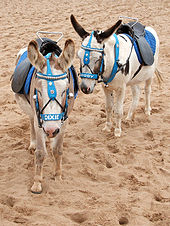
Classic British seaside donkeys in Skegness
Donkeys vary considerably in size, depending on breed and management. The height at the withers ranges from 7.3 to 15.3 hands (31 to 63 inches, 79 to 160 cm), and the weight from 80 to 480 kg (180 to 1,060 lb). Working donkeys in the poorest countries have a life expectancy of 12 to 15 years;[16] in more prosperous countries, they may have a lifespan of 30 to 50 years.[5]
Donkeys are adapted to marginal desert lands. Unlike wild and feral horses, wild donkeys in dry areas are solitary and do not form harems. Each adult donkey establishes a home range; breeding over a large area may be dominated by one jack.[17] The loud call or bray of the donkey, which typically lasts for twenty seconds[18][19] and can be heard for over three kilometres, may help keep in contact with other donkeys over the wide spaces of the desert.[20] Donkeys have large ears, which may pick up more distant sounds, and may help cool the donkey's blood.[21] Donkeys can defend themselves by biting, striking with the front hooves or kicking with the hind legs.
Breeding
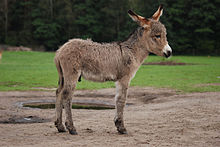
A 3-week-old donkey
A jenny is normally pregnant for about 12 months, though the gestation period varies from 11 to 14 months,[5][22] and usually gives birth to a single foal. Births of twins are rare, though less so than in horses.[5] About 1.7 percent of donkey pregnancies result in twins; both foals survive in about 14 percent of those.[23] In general jennies have a conception rate that is lower than that of horses (i.e., less than the 60–65% rate for mares).[5]
Although jennies come into heat within 9 or 10 days of giving birth, their fertility remains low, and it is likely the reproductive tract has not returned to normal.[5] Thus it is usual to wait one or two further oestrous cycles before rebreeding, unlike the practice with mares. Jennies are usually very protective of their foals, and some will not come into estrus while they have a foal at side.[24] The time lapse involved in rebreeding, and the length of a jenny's gestation, means that a jenny will have fewer than one foal per year. Because of this and the longer gestation period, donkey breeders do not expect to obtain a foal every year, as horse breeders often do, but may plan for three foals in four years.[5]
Donkeys can interbreed with other members of the family Equidae, and are commonly interbred with horses. The hybrid between a jack and a mare is a mule, valued as a working and riding animal in many countries. Some large donkey breeds such as the Asino di Martina Franca, the Baudet de Poitou and the Mammoth Jack are raised only for mule production. The hybrid between a stallion and a jenny is a hinny, and is less common. Like other inter-species hybrids, mules and hinnies are usually sterile.[5] Donkeys can also breed with zebras in which the offspring is called a zonkey (among other names).
Behaviour
Donkeys have a notorious reputation for stubbornness, but this has been attributed to a much stronger sense of self-preservation than exhibited by horses.[25] Likely based on a stronger prey instinct and a weaker connection with humans, it is considerably more difficult to force or frighten a donkey into doing something it perceives to be dangerous for whatever reason. Once a person has earned their confidence they can be willing and companionable partners and very dependable in work.[26]
Although formal studies of their behaviour and cognition are rather limited, donkeys appear to be quite intelligent, cautious, friendly, playful, and eager to learn.[27]
History
See also: Evolution of the horse
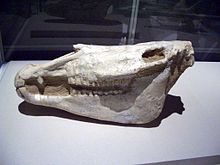
Skull of a giant extinct horse, Equus eisenmannae
The genus Equus, which includes all extant equines, is believed to have evolved from Dinohippus, via the intermediate form Plesippus. One of the oldest species is Equus simplicidens, described as zebra-like with a donkey-shaped head. The oldest fossil to date is ~3.5 million years old from Idaho, USA. The genus appears to have spread quickly into the Old World, with the similarly aged Equus livenzovensis documented from western Europe and Russia.[28]
Molecular phylogenies indicate the most recent common ancestor of all modern equids (members of the genus Equus) lived ~5.6 (3.9–7.8) mya. Direct paleogenomic sequencing of a 700,000-year-old middle Pleistocene horse metapodial bone from Canada implies a more recent 4.07 Myr before present date for the most recent common ancestor (MRCA) within the range of 4.0 to 4.5 Myr BP.[29] The oldest divergencies are the Asian hemiones (subgenus E. (Asinus), including the kulan, onager, and kiang), followed by the African zebras (subgenera E. (Dolichohippus), and E. (Hippotigris)). All other modern forms including the domesticated horse (and many fossil Pliocene and Pleistocene forms) belong to the subgenus E. (Equus) which diverged ~4.8 (3.2–6.5) million years ago.[30]

Donkey in an Egyptian painting c. 1298–1235 BC
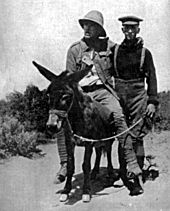
Lt. Richard Alexander "Dick" Henderson using a donkey to carry a wounded soldier at the Battle of Gallipoli.
The ancestors of the modern donkey are the Nubian and Somalian subspecies of African wild ass.[31][32] Remains of domestic donkeys dating to the fourth millennium BC have been found in Ma'adi in Lower Egypt, and it is believed that the domestication of the donkey was accomplished long after the domestication of cattle, sheep and goats in the seventh and eighth millennia BC. Donkeys were probably first domesticated by pastoral people in Nubia, and they supplanted the ox as the chief pack animal of that culture. The domestication of donkeys served to increase the mobility of pastoral cultures, having the advantage over ruminants of not needing time to chew their cud, and were vital in the development of long-distance trade across Egypt. In the Dynasty IV era of Egypt, between 2675 and 2565 BC, wealthy members of society were known to own over 1,000 donkeys, employed in agriculture, as dairy and meat animals and as pack animals.[33] In 2003, the tomb of either King Narmer or King Hor-Aha (two of the first Egyptian pharaohs) was excavated and the skeletons of ten donkeys were found buried in a manner usually used with high ranking humans. These burials show the importance of donkeys to the early Egyptian state and its ruler.[34]
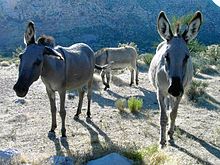
Feral burros in Red Rock Canyon
By the end of the fourth millennium BC, the donkey had spread to Southwest Asia, and the main breeding center had shifted to Mesopotamia by 1800 BC. The breeding of large, white riding asses made Damascus famous[citation needed], while Syrian breeders developed at least three other breeds, including one preferred by women for its easy gait. The Muscat or Yemen ass was developed in Arabia. By the second millennium BC, the donkey was brought to Europe, possibly at the same time as viticulture was introduced, as the donkey is associated with the Syrian god of wine, Dionysus. Greeks spread both of these to many of their colonies, including those in what are now Italy, France and Spain; Romans dispersed them throughout their empire.[33]
The first donkeys came to the Americas on ships of the Second Voyage of Christopher Columbus, and were landed at Hispaniola in 1495.[35] The first to reach North America may have been two animals taken to Mexico by Juan de Zumárraga, the first bishop of Mexico, who arrived there on 6 December 1528, while the first donkeys to reach what is now the United States may have crossed the Rio Grande with Juan de Oñate in April 1598.[36] From that time on they spread northward, finding use in missions and mines. Donkeys were documented as present in what today is Arizona in 1679. By the Gold Rush years of the 19th century, the burro was the beast of burden of choice of early prospectors in the western United States. With the end of the placer mining boom, many of them escaped or were abandoned, and a feral population established itself.
'수, 당나라 > 당나라' 카테고리의 다른 글
| <펌> 불림 (拂펼칠불, 林수풀림) - 두산백과 (0) | 2023.07.09 |
|---|---|
| <펌>당 태종 - 나무위키 (0) | 2020.12.05 |
| <펌>Carrot (0) | 2020.11.30 |
| <펌> 당나귀, 그리고 당근과 채찍이야기 (0) | 2020.11.29 |
| <펌>당나귀 - 한국민족문화대백과 (0) | 2020.11.29 |